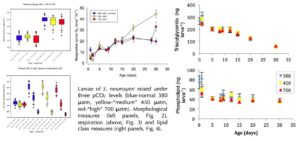PI: Pauline Yu
Contact Information:
Research institution: University of California, Santa Barbara
Email: pauline.yu@lifesci.ucsb.edu
Website: http://hofmannlab.msi.ucsb.edu/
As a senior postdoc in the Hofmann lab, I have been actively involved in two major data collection efforts related to ocean acidification. While my current appointment is under the auspices of the Office of Polar Programs, I continue to be involved with data collection related to local experiments.
I have been a collaborator with graduate student Paul Matson and Prof. Todd Martz in managing the collection of ocean pH data using SeaFET sensors developed by Prof. Martz, and also in conducting informal pH monitoring of the seawater system on the UCSB campus. The first Santa Barbara pH dataset capturing summer upwelling activity was published recently as Yu et al., 2011 in JEMBE. I have assisted with additional SeaFET deployment activities in Antarctica, and am participating in the dissemination of those results. In the meantime, I am also supervising a visiting foreign student in the regular collection of pH data on the on campus seawater system at UCSB (Fig. 1). As the campus has a flow-through seawater system with an intake just off of Campus Point in Goleta, continuous monitoring of seawater in the pipes (both filtered and unfiltered at different points in the system) shows that despite a small but consistent increase in pCO2 related to internal biofouling, sampling of the pipe seawater fairly closely reflects the nearshore seawater chemistry (2500ft off the beach at 51ft depth) over a temporal scale of days to months. As shown by Juranek et al, 2010, there is a close association between temperature and pH over time during upwelling season.
![]()

Figure 1. pH and temperature of the seawater system at UCSB from early February-late June 2011. Dashed dark blue line marks pH 8.0, blue line shows pH (as measured by discrete spectrophotometric pH samples) and red line shows temperature.
My main research efforts have been in studying physiological changes in sea urchin larvae under high CO2. Experiments in collaboration with Paul Matson have revealed small but significant differences in size in purple urchin Strongylocentrotus purpuratus that are also affected by maternal biochemical contribution. Some of these data have already been published as Yu et al., 2011, a second manuscript is in preparation, and additional data are being collected from these experiments on S. purpuratus. Last summer, I supervised an undergraduate experiment on fertilization success under high CO2 and high temperature in Lytechinus pictus. We observed some abnormal fertilization under high CO2 conditions, which are being followed up by another postdoc, Dr. Jessica Dutton. This summer I will be supervising an experiment on larvae of L. pictus performed by undergraduate interns. While in Antarctica, I have been studying the polar species Sterechinus neumayeri, which similarly appears to have diminished size in response to high CO2 (Fig. 2). However, metabolic rate data shows that there appear to be no negative effects on respiration in S. neumayeri embryos, but some later differentiation (Fig. 3). Lipid biochemistry (Fig. 4) also seems fairly similar under normal and high CO2 conditions, but those analyses are ongoing. We are planning additional analyses of enzyme activity, gene expression and proteomic data.
